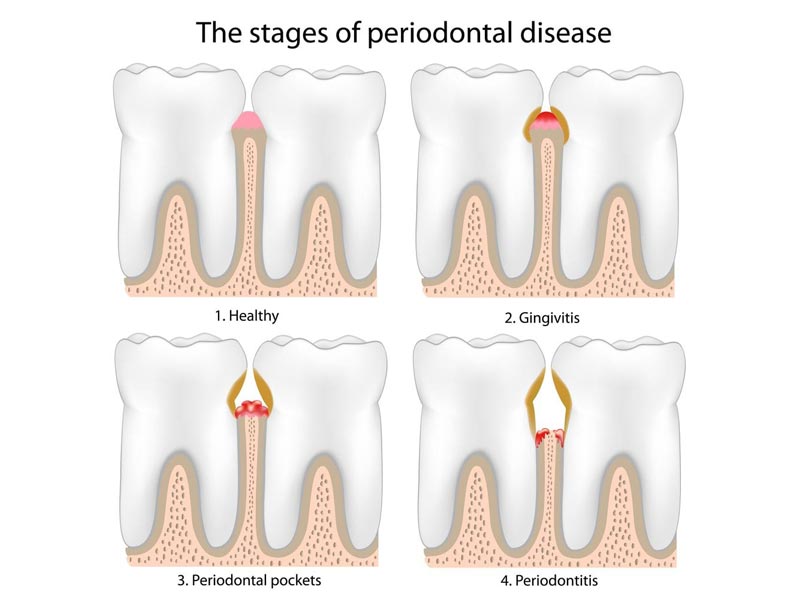Periodontal Disease
Signs & Symptoms of Periodontal Disease
Periodontal disease – also known as gingivitis and periodontitis – is most easily identified by the visible symptoms it causes as it progresses. In its beginning stages, a periodontal disease often causes no symptoms at all, making it difficult for the average person to notice. Periodontal disease is a highly common infection of the periodontal tissues (gums and bone) that are responsible for supporting the teeth. These infections are caused by bacteria that grow on the teeth near the gum line due to poor brushing and flossing practices. With time, bacteria begin causing inflammation in the gums, which may result in reddening or gums that are tender, swollen and bleed easily. As bacteria continues to proliferate, the teeth may begin to appear longer due to a receding gum line. Eventually, pockets may begin to form between the gums and teeth, which can lead to loosened teeth or total tooth loss. Other symptoms of periodontal disease may include chronic bad breath and mouth sores. Allowed to progress untreated, an advanced periodontal disease may cause pain, receding gums and pockets between the gums and teeth. Known as periodontitis, this type of periodontal disease is the leading cause of tooth loss among American adults – even more so than decay.

Periodontal Scaling & Root Planing
Periodontal scaling and root planing are procedures used to treat periodontal disease. Thought of by many as a ‘deep cleaning’, this in-office procedure involves the careful removal of hardened plaque near the gum line, where harmful bacteria can grow and cause damage to both the hard and soft tissues of the mouth. The treatment starts with scaling, during which special instruments are used to scrape tartar away from the teeth and gums. Root planing follows, which is a process of smoothing the surface of the tooth’s root in order to prevent bacteria from accumulating there in the future. Finally, an antibiotic called Arestin is administered into the gum pockets to ensure that no bacteria remain at the treatment site.


Did You Know?
Periodontal disease is a serious oral health problem that affects nearly half of American adults. It is easily treated in its earliest stages, although many people do not know they have it until symptoms appear – often not until it has progressed to moderate or severe stages that require more complex treatments. The most effective way of finding and preventing periodontal disease is by adopting good oral hygiene and attending periodic dental cleanings and exams.
That you cannot brush or rinse away hardened plaque that causes periodontal disease? The best way to prevent plaque accumulation is by using good brushing and flossing habits. Once tartar has formed, the only way to remove it is via a professional dental cleaning.
Bad gums could be as strong a risk factor for heart attacks as smoking cigarettes, which is blamed for about 40,000 heart-related deaths a year.
A study of fatty deposits lodged in the carotid arteries of stroke sufferers shows that 70% contain bacteria and 40% of that bacteria comes from the mouth.
Men with periodontal disease have a stronger propensity for cardio-vascular disease than men without periodontal disease, with those under 50 with periodontal disease having a greater risk than those over 50.
Diabetics with gum disease were more likely to have heart attacks than those without gum disease.
Women with gum disease are more likely to give birth prematurely to low-weight babies.
Bacteria in plaque are linked to lung infections in people with chronic lung diseases such as chronic obstructive pulmonary disease.
It appears that the extent of sites with probing depths>3mm is strongly related to the incidence of total coronary heart disease.
Studies also suggest that good oral hygiene habits may improve fertility in subfertile males.
Frequently Asked Questions
You may need scaling and root planing if you are suffering from mild to moderate periodontal disease. Visit Dr. Sammons and Dr. Laurent for an exam if you are experiencing any of the symptoms of periodontal disease, such as inflamed or receding gums, chronic halitosis, or loose teeth.
If you require a scaling and root planing, you’ll first be made comfortable utilizing our office’s several luxury amenities such as aromatherapy facial towels, paraffin hand wax, hand massages, chenille throws, and custom selected music with over ear headphones. You should feel little or no discomfort other than the sensation of the cleaning tools removing hardened plaque. Procedure lengths vary according to the extent of the disease and the areas it is located within the mouth. If your periodontal disease is widespread, you may need to spread out your treatment into multiple visits.
Yes. You’ll need to follow all instructions for antibiotic usage following your treatment. You’ll also be advised to avoid certain habits that can cause recurrences of periodontal disease in the future, such as smoking. Most patients experience little or no discomfort after scaling and root planning, although your mouth may continue to be numb for several hours following the procedure.
Arestin is highly effective for destroying the bacteria that causes gum disease. However, it is possible that you will require additional treatments.
In the initial week to 10 days following Arestin treatment, you will need to avoid consuming hard, crunchy, and sticky foods such as candy and gum. You should also temporarily eliminate flossing from your dental routine. At the end of the treatment period, you may resume flossing and are encouraged to stop smoking (if applicable), as this can increase your risk of developing periodontal disease again in the future. So long as you adhere to a careful and hygienic dental routine, you should be able to prevent future incidences of gum disease.
